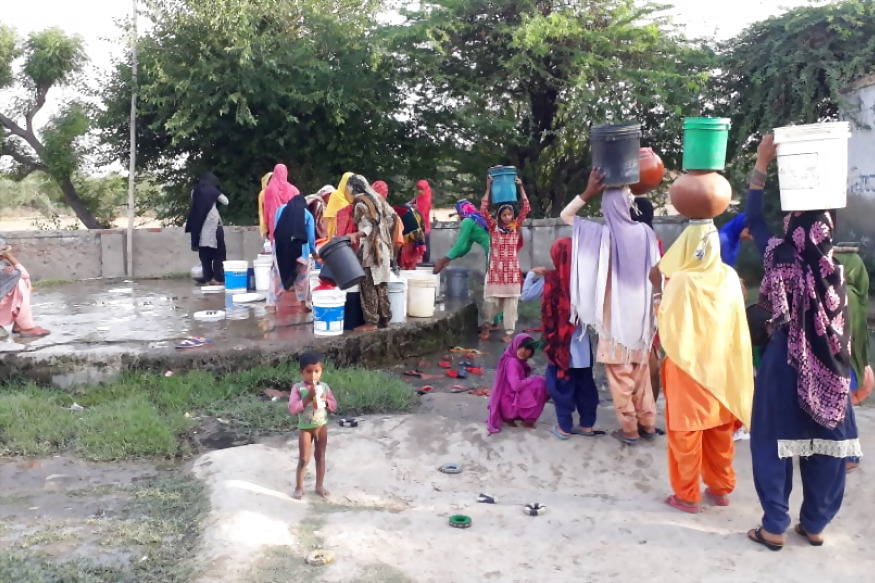
views
Nuh, Haryana: Fahim, 42, weighs merely 36 kilograms. With her 2-year-old baby tucked to her waist, she has 11 other children in 20 years of her marriage. Doctors had, five years ago, pointed out lack of blood in her body along with diagnosing anaemia. However, the couple decided to have three more children with multiple shots of iron and calcium injected into her during the time of delivery.
Fahim lives the common story of almost every other woman in Haryana’s Nuh district, less than 60 kilometres from Gurugram’s extravagance. The family survey of 2015-16 by Ministry of Health and Family Welfare concluded that the district has the highest percentage of women and children with anaemia and most number of births without the presence of a health professional.
“Children are gifts of God. They are our happiness,” says Hakumuddin, Fahim’s husband who works as an agricultural worker in the nearby farm and makes roughly Rs 8,000 a month. He refuses to believe that the lack of blood in his wife’s body is due to multiple pregnancies. He blames her eating habits.
“She does not eat vegetables. I keep insisting she have a better meal but she gives most of the food to her children,” he says. Fahim smiles at his complaint. Her wrinkled face stretches into her sunken cheeks. She caresses her youngest child, her bony hand on his head, and says, “How can I eat and keep them hungry.”
Local doctors remember diagnosing her. “We had asked the couple to concentrate more on nutrition now as the woman is becoming weaker with every child that she bears. There is serious shortage of blood and iron in her body. She is calcium deficient too. She should not have more children,” said Dr Govind Saran, senior medical officer in Nuh.
The lack of prosperity in the family can easily deciphered from the thatched roof, half-sewn cots and lack of proper clothes on the children, a sight not very different for almost every family in the area. Nuh was right at the bottom of the list of aspirational district published by NITI Aayog last year.
Dr. Amita, stationed at the district hospital, faces at least 15 cases of women suffering from lack of blood on a daily basis. She attributes the problem to persistent lack of nutrition and no family planning.

Women all over Nuh take atleast 15 trips daily to fetch water. The crisis has been omnipotent since independence.
Data sourced from the Ministry of Health in Haryana states that 153 women and 47 infants die every year in the state due to lack of blood. Specifically for Mewat, more than 80 per cent of women have been diagnosed having less than healthy levels of blood in them and close to 30 percent have been declared critical.
Merely two houses away from Fahim’s, the story of back-to-back pregnancies leading to acute shortage of blood repeats itself. Here, it has passed on to the next generation as well.
Jamshida, 47, has 13 children. It has been six years since she was first diagnosed with anaemia and shortage of blood. Much like her peers, she too did not consider it important. Now, her eldest daughter, Shabnam is facing the same health concern. She has four children in the seven years of her marriage.
“Did anything happen to my mother? She is perfectly alright. I will also not face any problem. The lack of blood and iron is because of the insane amount of work that we women do,” she says.
Shabnam is partially correct. She explains the daily routine of Nuh’s rural women. “We wake up at 4:30 in the morning and end our day at midnight. Right from providing food to the animals, cooking, taking care of our children, sometimes working for a few hours as an agricultural labour and mostly importantly filling water, we are running the entire day,” she says.
“15 trips for water daily,” she adds.
Dr Amita, who mostly treats women in the area, confirms that the lack of nutrition also arises from constant labour. “These women get no rest. They keep fetching water in large vessels throughout the day, working more than they eat. There is no fixed time for their food intake. It is a problem that will only end if sufficient nutrition is provided on a daily basis. And that can only happen if the water crisis is addressed,” she prescribes.
The dual problem materializes as one enters Golpuri village in Nuh. Women here can be seen doing only two things, fetching buckets of water on their head and carrying babies on their waist.
“The water chamber is our only source of water. The men go out to work and we keep filling buckets after buckets. The whole family needs water throughout the day. 15-20 trips is a daily affair,” says Akhtari, a resident of the village.
Every village has only one chamber where the municipal corporation supplies water. Private tanks costs almost Rs 1,500 and several villagers informed that it lasts merely two weeks. Women walk at least a couple of kilometres to collect water.
This part of Haryana has been facing water woes for the last 45 years. Standing next to defunct canal in the village, locals point to the grass that has grown in the middle.
“The canal was built when Om Prakash Chautala was the chief minister but water never came down this canal. Water was released for just a day in order to check its supply,” adds Akhtari.

Jamshida with her children in a village in Nuh
Locals say that the first demand for a separate canal through Mewat district was made in 1972. A scheme launched by the UPA government in 2004 failed to change the fortunes of the place.
The current BJP government also has not taken up this long standing demand.
“MP Rao Inderjit Singh has never even visited the area in the last five years, let alone getting water for us,” complain locals. With the district moving to polls on 12 May, the issue has found no resonance in any of the election speeches but locals are hopeful that the Congress will provide them "NYAY."
Roughly 20 kilometres from the village, Bismillah, 62, exemplifies the grave problem that the district has been facing. A resident of Akeda village in Nuh district, she has 24 children. She does even remember the names of all of them.
Mohammed Ishaaq, her husband refuses to call it a problem. “I am a proud parent. Why is that supposed to be a problem? The money gets divided, yes, but it is one happy large family,” he says.
No amount of awareness campaigns by local ASHA workers on the use of contraceptives or getting a tubectomy and vasectomy have deterred the couple’s beliefs.
In about 42 years of their married life, this couple has parented as many as 24 children, their scanty resources notwithstanding. Though all of their children could not survive, they have set a benchmark of sorts in their own right.
The couple also hit the headlines in the international media after Bismillah gave birth to their 23rd child in 2007. However, they are disillusioned with the government as well as the media.
“We do not have a BPL ration card till date and the government machinery has not done us any good to speak of,” says Ishaq. He also accuses the mediapersons of exhibiting his family to further their own interest without getting anything worthwhile for them.
“Most local residents not only refuse to undergo surgeries to check pregnancies after the birth of one or two offspring, but also say a firm no to all sorts of contraceptives as they consider children Allah ki den,” says a local ASHA worker from the area.















Comments
0 comment